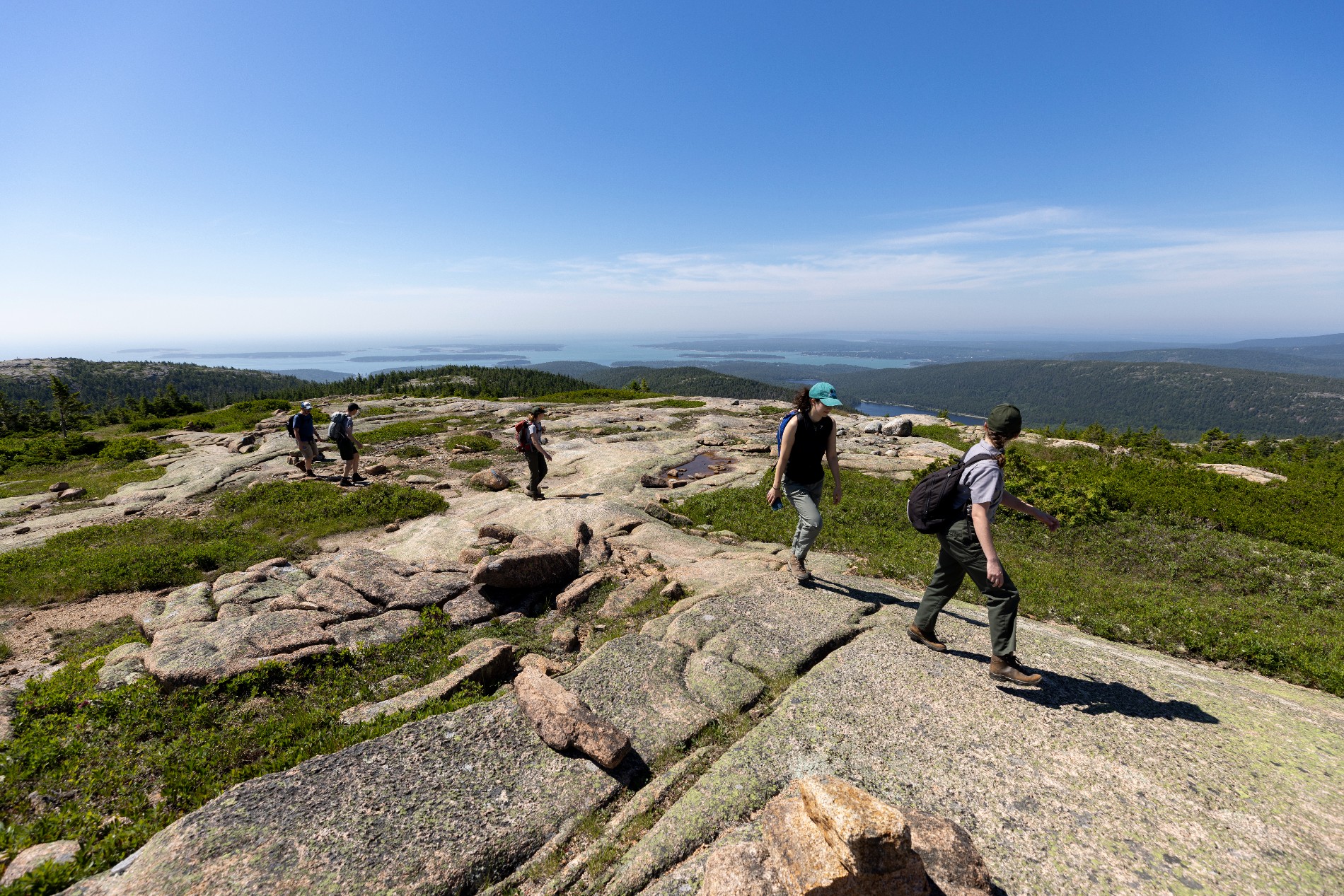The Dirt on Acadia
Writer Nicholas Lund captured his “day as a pack animal on Sargent Mountain” in a recent story for National Parks Conservation Association.
January 7th, 2025
Writer Nicholas Lund captured his “day as a pack animal on Sargent Mountain” in a recent story for National Parks Conservation Association.
January 7th, 2025
Writer Nicholas Lund learned how heavy 20 pounds can feel when it’s tucked into your backpack during a Save Our Summits hike this summer. He joined a group of volunteers to carry soil to the summit of Sargent Mountain. The soil-schleping effort is part of ongoing summit restoration work happening in Acadia National Park, and that soil is an instrumental ingredient.
Despite growing in hard conditions, Acadia’s mountain plants are not adapted to foot traffic, and decades of trampling by humans has damaged plant communities and eroded soil at the top of mountains. More frequent extreme weather events, which damage landscapes, cultural resources, and infrastructure, are speeding the loss of soil and making it harder for plants to grow back on their own.
For the last several years, Acadia National Park, Friends of Acadia, Schoodic Institute, and Native Plant Trust worked together to evaluate how to best restore Acadia’s summits. Turns out, replacing soil lost from the summits is a critical piece of the revegetation puzzle, providing a place for seeds to settle and grow.
Save Our Summits hikes ran weekly all summer and volunteers carried upwards of 4,338 pounds of soil to the summits.
Here’s an excerpt from the National Parks Conversation Association story:
It was a gorgeous morning in late June, and we were in what might be the most idyllic section of Acadia National Park. We stood at the edge of Hemlock Bridge, one of the park’s famous stone archways, listening to the waters of Maple Spring Brook trickle below. A light breeze rustled the canopy of hardwoods and conifers overhead, and sunlight speckled the crushed gravel of the carriage road.
 It was a perfect day, but I wasn’t there to enjoy the views. We had work to do. Just behind us, a trail cut 2 miles steeply uphill through forest and boulders and ultimately to the granite summit of Sargent Mountain. The National Park Service wanted to bring thousands of pounds of soil up to the peak to help save the park’s most imperiled ecosystem, and managers had determined that the best way to do it was for us, a group of regular people, to lug the dirt there on our backs.
It was a perfect day, but I wasn’t there to enjoy the views. We had work to do. Just behind us, a trail cut 2 miles steeply uphill through forest and boulders and ultimately to the granite summit of Sargent Mountain. The National Park Service wanted to bring thousands of pounds of soil up to the peak to help save the park’s most imperiled ecosystem, and managers had determined that the best way to do it was for us, a group of regular people, to lug the dirt there on our backs.
So instead of enjoying the breeze or taking pictures of the stream, we paced and fretted, wondering how much extra weight we could each carry along with the water and snacks in our daypacks. Nearby, park staff carefully weighed plastic bags of dark soil, each between 5 and 20 pounds, and asked us how much we wanted.
Feeling macho, I opted for 20 pounds and tested the feel of the deadweight in my backpack. Unpleasant. I arranged and rearranged the soil until it was tolerably comfortable, while the 20 or so volunteers went through their own rejiggering process. Once all the clips were clipped and the straps were strapped, it was time to hike.
The goal of the Save Our Summits project is to restore native vegetation atop Acadia’s famous granite peaks. Conditions are tough up there: Glacial scouring and a punishing climatic rotation of wind, ice, fog and sun have historically left the soil on top of the park’s mountains thin and nutrient-poor. Yet patches of mountaintop soil, which resist erosion when sheltered by boulders or squeezed into crevices, host remarkable communities of subalpine plants. More than 100 species of plants grow on Acadia’s peaks, most of them typically found much farther north or on higher mountains.

Volunteers hike with soil in their bags during a soil restoration hike up Sargent Mountain. (Evie Linantud/Friends of Acadia)
“The types of plants that grow here don’t really grow anywhere else on the Eastern Seaboard,” said Jesse Wheeler, Acadia’s vegetation biologist, who was hiking with us.
Unfortunately, these stalwart plants have to contend with more than just harsh winters. Humans have added what Wheeler calls “erosion vectors” to the summits, putting increased strain on an already fragile ecosystem. Hiking trails get lost on the open, rocky peaks, and hikers tramp through the plant communities, creating social trails and breaking up the soil with their footsteps. Climate change, too, has caused an uptick in erosion with more rainfall, stronger storms and increasingly fluctuating temperatures.
> Read the full story: The Dirt on Acadia
> Learn more about 2024’s Save Our Summit hikes and summit restoration work in Acadia.